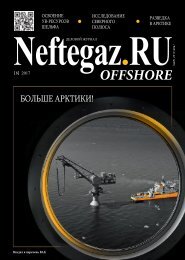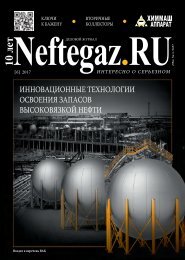Neftegaz.RU #3-17 ENG
Create successful ePaper yourself
Turn your PDF publications into a flip-book with our unique Google optimized e-Paper software.
EQUIPMENT<br />
FIG. 4. Diagram of the mine rock destruction with elementary section of the cutting element in<br />
the process of drilling<br />
Computational pattern for<br />
mathematical description of the<br />
cutting process with a cutter having<br />
single width [1], given in the Figure<br />
4, is proposed based on the analysis<br />
of the records made in the process<br />
of drilling and planning with various<br />
thickness of the cut rock layer and<br />
shares elements.<br />
It was established that shear angle<br />
of any element to the nearest<br />
exposed surface slightly differs from<br />
the rock shear angle , and the ratio<br />
of the chipping contact height to the<br />
shear line , is a constant<br />
value and falls within the limits of<br />
4 – 4.5 as applied to hard rocks.<br />
It means that inclination angle<br />
forming large and small waves on<br />
the downhole undulated surface<br />
in the process of drilling shall be<br />
determined using the following<br />
equation:<br />
and falls within<br />
the limits from 12.8° to 14.5°.<br />
In order to prevent cutting elements<br />
touchdown on the rear edge in the<br />
process of propagation through<br />
the top part at down grade of each<br />
wave, the rear angle shall be more<br />
than 14.5°. Let us take = 15°. As<br />
RDT reinforced with PCD inserts<br />
have constructively interrelated<br />
front angle and the rear angle<br />
(at the sharpening angle = 90°),<br />
the maximum negativeness at<br />
the minimum increase of the<br />
cutting force for new boring bits is<br />
represented by the front angle<br />
equal 15°.<br />
With consideration of the conducted<br />
investigations, we have been the<br />
first to propose the boring bits<br />
reinforced with PCD for drilling of the<br />
mine rocks of the VI – VIII drillability<br />
class (RF Patent 2359103), RF<br />
No. 242613, RF No. 2435927, RF<br />
FIG. 5. The stabilizing anti-vibration boring bit, profile view<br />
No. 2577351), and the stabilizing<br />
anti-vibration boring bit has been<br />
designed, manufactured and tested.<br />
The stabilizing anti-vibration boring<br />
bit (Fig. 5, 6) has a body 1 with с<br />
connecting thread 2, divided by the<br />
main water ports 3 into segments<br />
4, which on the end surface are<br />
provided with polycrystalline<br />
diamond inserts 5, differently<br />
directed at the angle of -15° to the<br />
direction of cutting.<br />
The main water ports 3 and auxiliary<br />
water ports 6 are designed in<br />
counter-current direction angle-wise.<br />
The main 3 and auxiliary 6 water<br />
ports are provided along the whole<br />
body 1 height in screw line to the<br />
right in the bit rotation direction.<br />
Height of the bit body 1 depends<br />
on the screw line pitch of the main<br />
3 and auxiliary 6 water ports; inside<br />
the auxiliary water ports 6 there<br />
are two or more polycrystalline<br />
diamond calibration inserts 7, each<br />
of them represents the element of<br />
a separate screw line, these inserts<br />
are attached to the body by means<br />
of soldering and are designed for the<br />
well side wall processing.<br />
When highly-abrasive rocks are<br />
drilled, the bit is equipped with not<br />
two but four rows of the calibrators,<br />
i.e. 12 pieces of PCD 10 mm.<br />
50 ~ <strong>Neftegaz</strong>.<strong>RU</strong> [3]














